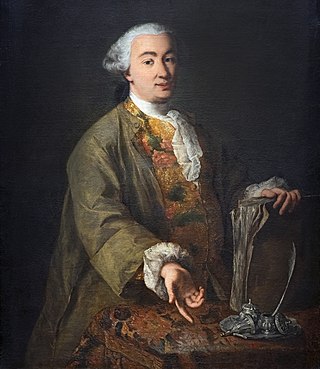
Carlo Osvaldo Goldoni was an Italian playwright and librettist from the Republic of Venice. His works include some of Italy's most famous and best-loved plays. Audiences have admired the plays of Goldoni for their ingenious mix of wit and honesty. His plays offered his contemporaries images of themselves, often dramatizing the lives, values, and conflicts of the emerging middle classes. Though he wrote in French and Italian, his plays make rich use of the Venetian language, regional vernacular, and colloquialisms. Goldoni also wrote under the pen name and title Polisseno Fegeio, Pastor Arcade, which he claimed in his memoirs the "Arcadians of Rome" bestowed on him.
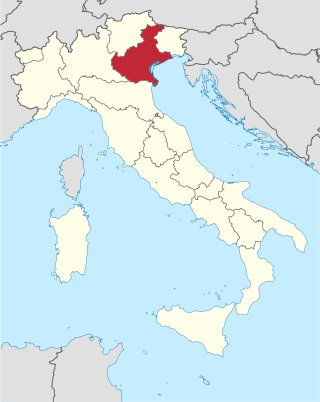
Veneto or Venetia is one of the 20 regions of Italy. Its population is about five million, ranking fourth in Italy. The region's capital is Venice while the biggest city is Verona.
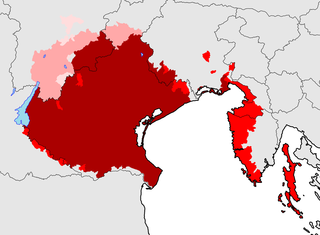
Venetian, wider Venetian or Venetan is a Romance language spoken natively in the northeast of Italy, mostly in the Veneto region, where most of the five million inhabitants can understand it. It is sometimes spoken and often well understood outside Veneto: in Trentino, Friuli, the Julian March, Istria, and some towns of Slovenia and Dalmatia (Croatia) by a surviving autochthonous Venetian population, and Brazil, Argentina, Australia, Canada, the United States, the United Kingdom, and Mexico by Venetians in the diaspora.

The Gallerie dell'Accademia is a museum gallery of pre-19th-century art in Venice, northern Italy. It is housed in the Scuola della Carità on the south bank of the Grand Canal, within the sestiere of Dorsoduro. It was originally the gallery of the Accademia di Belle Arti di Venezia, the art academy of Venice, from which it became independent in 1879, and for which the Ponte dell'Accademia and the Accademia boat landing station for the vaporetto water bus are named. The two institutions remained in the same building until 2004, when the art school moved to the Ospedale degli Incurabili.
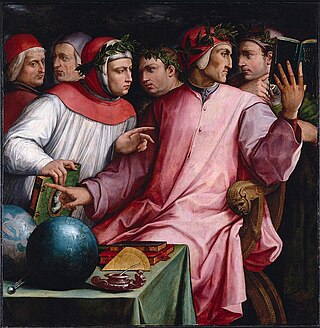
Italian literature is written in the Italian language, particularly within Italy. It may also refer to literature written by Italians or in other languages spoken in Italy, often languages that are closely related to modern Italian, including regional varieties and vernacular dialects. Italian literature begins in the 12th century, when in different regions of the peninsula the Italian vernacular started to be used in a literary manner. The Ritmo laurenziano is the first extant document of Italian literature.
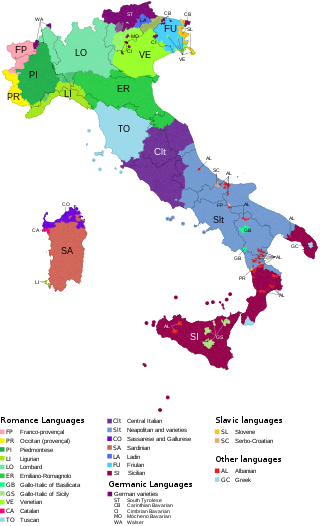
The languages of Italy include Italian, which serves as the country's national language, in its standard and regional forms, as well as numerous local and regional languages, most of which, like Italian, belong to the broader Romance group. The majority of languages often labeled as regional are distributed in a continuum across the regions' administrative boundaries, with speakers from one locale within a single region being typically aware of the features distinguishing their own variety from one of the other places nearby.

The Veronese Riddle is a riddle written in late Vulgar Latin, or early Romance, on the Verona Orational, probably in the 8th or early 9th century, by a Christian monk from Verona, in northern Italy. It is an example of a writing-riddle, a popular genre in the Middle Ages and still in circulation in recent times. Discovered by Luigi Schiaparelli in 1924, it may be the earliest extant example of Romance writing in Italy.

Giovanni Domenico Nardo was an Italian naturalist from Venice, although he spent most of his life in Chioggia, home port of the biggest fishing flotilla of the Adriatic. He learned taxidermy and specimen preparation from his uncle, an abbot. He went in a high school in Udine and studied medicine in Padua, where he reorganized the zoological collections. In 1832 he reorganized the invertebrate collection at the Imperial Natural History Museum in Vienna and in 1840 he became Fellow of the Istituto Veneto di Scienze, Lettere ed Arti, an academy whose aim is "to increase, promulgate, and safeguard the sciences, literature and the arts". Nardo wrote hundreds of scientific publications ranging from medicine and social sciences, philology, technology, physics, but mostly on Venetian and Adriatic zoology. In marine biology, Nardo wrote on algae, marine invertebrates, fishes and sea turtles. A vast collection of his manuscripts and his personal library is preserved in the Natural History Museum of Venice.
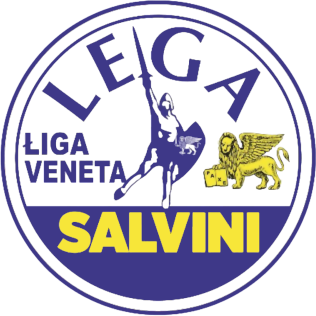
Liga Veneta, whose complete name is Liga Veneta per Salvini Premier, is a regionalist political party active in Veneto.

Biagio Marin (1891–1985) was a Venetian poet, best known for his poems in the Venetian language, which had no literary tradition until then. In his writings he never obeyed rhetoric or poetics. He only employed a few hundred words for his poems.

Franco Rocchetta is an Italian politician, entrepreneur, philologist and history populariser, who is usually described as the "father" of present-day Venetian nationalism and independentism.

Venetian nationalism is a nationalist, but primarily regionalist, political movement active mostly in Veneto, Italy, as well as in other parts of the former Republic of Venice.
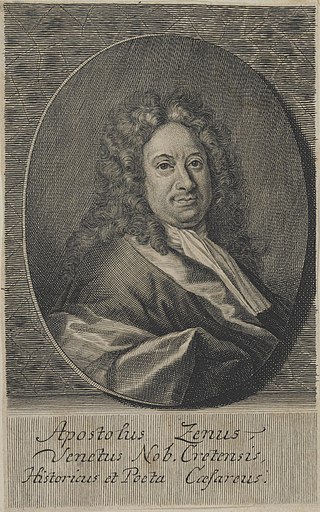
Apostolo Zeno was a Venetian poet, librettist, journalist, and man of letters.

Gaetano Cozzi was an Italian historian, professor at Padua University, and researcher with the Giorgio Cini Foundation and Fondazione Benetton Studi e Ricerche. He was a specialist in Venetian history, with special attention to the institutions, the relationship between law and society and the cultural environment.

Antonio Cappello (1494-1565) was a Venetian noble, a member of the San Polo branch of the Cappello family [it:Cappello (famiglia)]. A Procurator of St Mark's, he acted as ambassador to the court of Charles V at Gand, but is mainly remembered for his role as one of the main promoters of public art and architectural projects in sixteenth-century Venice. He resided in the palazzo on San Polo now known as Ca Cappello Layard and oversaw its redevelopment.
Gregory Dowling is an author, translator, literary critic and Professor of Anglo-American Literature at the Università Ca’ Foscari in Venice.

Angela Veronese was an Italian poet.

Minerva between Geometry and Arithmetic is a 1550 fresco fragment, usually attributed to Paolo Veronese but by some art historians to Anselmo Canera or Giambattista Zelotti. It was painted for the Palazzo de Soranzi in Castelfranco Veneto but now in the Palazzo Balbi in Venice.
Gianfranco Folena was an Italian linguist, philologist, and academic.
















